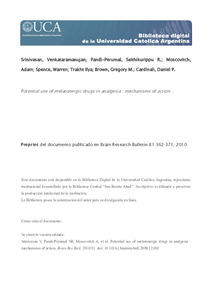Por favor, use este identificador para citar o enlazar este ítem:
https://repositorio.uca.edu.ar/handle/123456789/1633| Título: | Potential use of melatonergic drugs in analgesia : mechanisms of action | Autor: | Srinivasan, Venkataramanujan Pandi Perumal, Seithikurippu R. Moscovitch, Adam Spence, David Warren Trakht, Ilya Brown, Gregory M. Cardinali, Daniel Pedro |
Palabras clave: | ANALGESIA; MELATONINA; RECEPTORES DE MELATONINA; NOCICEPTORES; RECEPTORES DE OPIOIDES | Fecha de publicación: | 2010 | Editorial: | Elsevier | Cita: | Srinivasan, V., et al. Potential use of melatonergic drugs in analgesia : mechanisms of action. Preprint de artículo publicado en Brain Research Bulletin. 2010, 81. doi:10.1016/j.brainresbull.2009.12.001 Disponible en: https://repositorio.uca.edu.ar/handle/123456789/1633 | Resumen: | abstract: Melatonin is a remarkable molecule with diverse physiological functions. Some of its effects are mediated by receptors while other, like cytoprotection, seem to depend on direct and indirect scavenging of free radicals not involving receptors. Among melatonin´s many effects, its antinociceptive actions have attracted attention. When given orally, intraperitoneally, locally, intrathecally or through intracerebroventricular routes, melatonin exerts antinociceptive and antiallodynic actions in a variety of animal models. These effects have been demonstrated in animal models of acute pain like the tail-flick test, formalin test or endotoxin-induced hyperalgesia as well as in models of neuropathic pain like nerve ligation. Glutamate, gamma-aminobutyric acid, and particularly, opioid neurotransmission have been demonstrated to be involved in melatonin´s analgesia. Results using melatonin receptor antagonists support the participation of melatonin receptors in melatonin´s analgesia. However, discrepancies between the affinity of the receptors and the very high doses of melatonin needed to cause effects in vivo raise doubts about the uniqueness of that physiopathological interpretation. Indeed, melatonin could play a role in pain through several alternative mechanisms including free radicals scavenging or nitric oxide synthase inhibition. The use of melatonin analogs like the MT1/MT2 agonist ramelteon, which lacks free radical scavenging activity, could be useful to unravel the mechanism of action of melatonin in analgesia. Melatonin has a promising role as an analgesic drug that could be used for alleviating pain associated with cancer, headache or surgical procedures. | URI: | https://repositorio.uca.edu.ar/handle/123456789/1633 | ISSN: | 0361-9230 | Disciplina: | MEDICINA | DOI: | 10.1016/j.brainresbull.2009.12.001 | Derechos: | Acceso Abierto | Fuente: | Brain Research Bulletin. 2010;81 |
| Aparece en las colecciones: | Artículos |
Ficheros en este ítem:
| Fichero | Descripción | Tamaño | Formato | |
|---|---|---|---|---|
| potential-use-melatonergic-analgesia.pdf | 550,68 kB | Adobe PDF |  Visualizar/Abrir |
Visualizaciones de página(s)
132
comprobado en 30-abr-2024
Descarga(s)
397
comprobado en 30-abr-2024
Google ScholarTM
Ver en Google Scholar
Altmetric
Altmetric
Este ítem está sujeto a una Licencia Creative Commons

